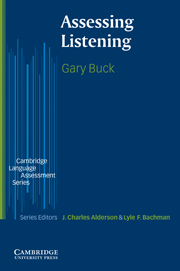Book contents
- Frontmatter
- Contents
- Series Editors' Preface
- Acknowledgements
- 1 An overview of listening comprehension
- 2 What is unique to listening
- 3 Approaches to assessing listening
- 4 Defining the construct
- 5 Creating tasks
- 6 Providing suitable texts
- 7 Designing and constructing complete assessments
- 8 Illustrative tests of listening comprehension
- 9 Summary and future developments
- Bibliography
- Index
7 - Designing and constructing complete assessments
Published online by Cambridge University Press: 03 May 2010
- Frontmatter
- Contents
- Series Editors' Preface
- Acknowledgements
- 1 An overview of listening comprehension
- 2 What is unique to listening
- 3 Approaches to assessing listening
- 4 Defining the construct
- 5 Creating tasks
- 6 Providing suitable texts
- 7 Designing and constructing complete assessments
- 8 Illustrative tests of listening comprehension
- 9 Summary and future developments
- Bibliography
- Index
Summary
Introduction
In earlier chapters, I discussed various aspects of test development: Chapter 4 looked at defining the construct, Chapter 5 looked at test tasks, and Chapter 6 looked at texts. In this chapter I will discuss how we bring all this together to construct complete listening tests.
Each testing situation is unique, and there are many different variables that affect test design and construction, so it is impossible to offer any hard and fast rules. I will begin by discussing important aspects of test design, and then illustrate these by discussing three sample test-design projects. Chapter 8 will examine large-scale tests, developed by professionals, and therefore the projects discussed in this chapter will be small scale. The three projects have been chosen to illustrate three common testing purposes, and three different approaches to construct definition: achievement tests, which define their construct by reference to a course of study, general proficiency tests, which define their construct by reference to a theoretical description of the listening ability, and tests of listening for special purposes, which define their construct by reference to a target-language use situation.
This chapter will be divided into five sections:
i some characteristics of good tests;
ii a discussion of test specifications;
iii designing an achievement test for a listening class;
iv designing a general test of listening proficiency;
v designing a test of listening for a specified purpose – academic listening.
Information
- Type
- Chapter
- Information
- Assessing Listening , pp. 194 - 208Publisher: Cambridge University PressPrint publication year: 2001
